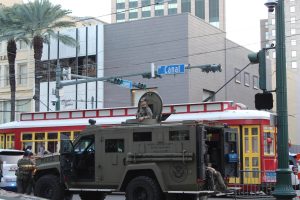Student activism catalyzes societal change
November 20, 2016
This is an opinion article and does not necessarily reflect the views of The Hullabaloo.
In 2014, a Pew Research Center poll found that 38 percent of Democrats and 43 percent of Republicans view the other party as fundamentally dangerous to the well-being of the United States. Contextualizing this data with the protests against President-elect Donald Trump and the systems of inequality he represents, the history of student activism is worth understanding to properly appreciate the scope of what we as students are capable of.
College and university students have been organizing and engaging in activism for as long as these institutions have existed. Beginning in colonial times, students protested the reign of the British Empire.
Student protests really took off, however, during the civil rights era. A major part of the movement was the Student Nonviolent Coordinating Committee, which worked closely with other civil rights leaders and organizations to organize protests, marches and voter registration drives. Many participants in the SNCC came from historically black colleges and universities.
Popular forms of activism involve gradual escalation. When one form of protest does not work, activists escalate their methods. In the civil rights era, protests escalated from sit-ins at white-only diners to peaceful protests to long, heavily publicized marches. Each escalation displays a continued commitment to the cause.
Protests today often feel less focused and effective than the protests we hear of from the civil rights era. The Occupy Wall Street movement fell flat, and despite Black Lives Matter protests gaining lots of media attention, so many of the police officers who should have been indicted or convicted have walked free.
Looking at the protests that have emerged after Trump’s victory, the question of effectiveness has been raised again. It is hard to imagine that marches and signs will stop Trump from taking office. Student anger and sadness have led to reactionary responses such as Iowa’s proposed “Suck It Up, Buttercup” bill, which aims to deny colleges and universities the right to cancel class due to students’ grief and fear.
There will always be opposition to social change. In 1965, a Gallup poll found that 61 percent of Southerners felt that the civil rights movement was moving too fast, compared to 42 percent in the rest of the country. Now, people feel similarly about Black Lives Matter with 42 percent in opposition to the movement.
It is worth making sacrifices to achieve social change. I consider protesting to be very similar to a sick day — it is our duty to nurse ingrained systems of oppression into health by dismantling them and replacing them with equitable ones. Especially for privileged students, justice requires sacrificing some of our privileges.
These protests have generated backlash, but that does not mean they are meaningless. It is important to have a goal going into a protest. Consider your personal connections to the cause and what you hope to get out of your activism. The true meaning of the anti-Trump protests is to display that we the people do not consent to this government, and we value the marginalized groups in this nation who will not feel valued under the Trump administration.
Beyond the general motivations for protest, students across the country have used the election as an excuse to pursue preexisting issues on their campuses. At Tulane, this opportunity came on Nov. 14. More than 100 students gathered at Gibson Hall and marched to McAlister Auditorium. Students marched for an expansion of the Office of Multicultural Affairs. As Tulane strives to increase diversity, it has not made a concentrated effort to expand the safe spaces on campus for multicultural students. Additionally, students asked for transportation services for contracted employees and greater attention to last year’s Call For Unity demands from Tulane Black Student Union.
While this protest was not political, its timing comes in the wake of the fear brought on by the election. These safe spaces for marginalized groups are more important than ever. This issue is complicated by the fact that some people perceive protests following the election as inherently political. One student yelled “Go Trump” at protesters. Right-wing news source Breitbart reported on the protest, calling out “perceived” racism by “social justice warriors.”
Looking at the map of the country, if only citizens aged 18-24 voted, nearly the entire country would have been blue. This popular analysis of the map, however, misses the fact that white millennials still voted in astonishingly high numbers for Trump. We need to keep this in mind — students of color have historically made a larger contribution to social change. White students need to step up as allies. “Ally” is a verb, not a noun, and it is time to prove it.
It is important for students to remember that we have the power to effect change. Throughout history, students have represented an extremely important part of political change. It is our job to know the history of activism and persevere. We must continue the legacy of student organizing, and we must ensure that our voices are not drowned out.
Sarah Simon is a student at Newcomb-Tulane College and can be reached at [email protected].









Leave a Comment